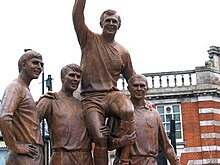World Cup Sculpture
 |
|
| Coordinates | 51°31′48.43″N 0°2′16.5″E / 51.5301194°N 0.037917°E |
|---|---|
| Location | Near the Boleyn Ground (Upton Park), home of West Ham United |
| Designer | Philip Jackson |
| Type | statue |
| Material | bronze sculpture |
| Height | 16 feet (4.9 m) |
| Beginning date | 2001 |
| Completion date | 2003 |
| Opening date | 28 April 2003 |
| Dedicated to | England's 1966 World Cup Final victory |
The World Cup Sculpture, or simply The Champions, is a bronze statue of the 1966 World Cup Final located near West Ham United Football Club's Boleyn Ground (Upton Park) stadium in the London Borough of Newham, England. It depicts a famous victory scene photographed after the final, held at the old Wembley Stadium in London, featuring Bobby Moore, Geoff Hurst, Martin Peters and Ray Wilson. It was the first and only time England had won the World Cup, and England captain Moore is pictured held shoulder high, holding the Jules Rimet Trophy aloft. Jointly commissioned by Newham Council and West Ham United, it stands at the junction of Barking Road and Green Street, near the Boleyn Ground. It commemorates West Ham's contribution to the victory, with Moore, Hurst and Peters having all been West Ham players at the time of the 1966 World Cup. Sculpted by the Royal Sculptor Philip Jackson, it was unveiled in 2003 by Prince Andrew, president of the Football Association. Jackson went on to also sculpt the statue of Bobby Moore unveiled at the new Wembley when it opened in 2007.
The work, titled by Jackson as The Champions or The World Cup Sculpture, is a one-and-a-half times life-size bronze piece, 16 feet (4.9 m) tall, weighing four tonnes. It stands in a prominent location at the junction of Barking Road (the A124) and Green Street in the London Borough of Newham, close to the home stadium of West Ham, the Boleyn Ground (commonly called Upton Park).
...
Wikipedia
